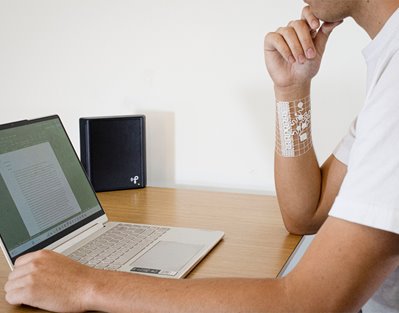3D Mesh Wearables Transmit Data, No Wi-Fi Required
3D Mesh Wearables Transmit Data, No Wi-Fi Required


A new set of wearables will make digital health more accessible by not requiring Wi-Fi or cellular connectivity to relay information over long distances.
Researchers at the University of Arizona have developed wearables that overcome a common obstacle associated with the current generation of such devices.
Unlike most wearables in use today, these new devices are imperceptible to the user and do not need Wi-Fi or internet connectivity to transmit data. They can also relay health information across distances of up to 15 miles, which is 2,400 times better than what Wi-Fi can accomplish.
As a result, these wearables have the potential to increase access to digital health for a wider swath of patients, including underserved populations in rural areas.
Wearable devices function as an important conduit between patient and doctor. By using sensors to measure biological functions, they can gather information outside of routine clinic visits and give physicians a better snapshot of patient health.
In addition to network connectivity limitations in current devices, bulky or inconvenient forms also discourage continual use, which leads to data gaps and incomplete health profiles.
The new 3D-printed mesh wearable from the lab of Philipp Gutruf, assistant professor of biomedical engineering at the University of Arizona, depends on an ubiquitous Long Range Wide Area Network (LoRaWAN) for connectivity and the LoRa standard to use this network technology efficiently. Adding LoRaWAN to rural areas is easy and does not require any special infrastructure or laying of cables. A fully autonomous access point to relay information to the next internet-connected point costs less than $200 and can serve hundreds of devices. It is why LoRaWAN has been very popular in bringing connectivity to remote areas, including parts of Africa.
Become a Member: How to Join ASME
An electronic sensing device embedded with LoRa hardware can piggyback on the connectivity that a LoRaWAN network offers. Internet of Things (IoT) technologies famously use LoRaWAN in remote areas.
In addition to LoRa communication, Gutruf’s devices feature the capability to be recharged at a short distance, unlike the average device that needs a stand. “If you put the charging device next to your bed, that’s hours of time to recharge your device without it needing to be taken off,” Gutruf said.
Instead of transmitting raw data, the wearable can also perform basic computations like heart rate trends and relay the corresponding results.
The impetus for coasting on a LoRaWAN network came from Gutruf questioning how to serve vulnerable populations who live without reliable internet connectivity.
Arizona, where Gutruf is based, has large rural areas with underserved Native American populations who have limited internet access, Gutruf pointed out. “Such populations could benefit from a technology that enables us to get quality data streams that are 24/7 that clinicians can access to make a diagnosis or manage disease,” he said.
Before he could access LoRaWAN connectivity, however, Gutruf had to ensure that the antenna needed could be accommodated in a wearable format.
A traditional wearable integrates all necessary sensors and computing units into one chip that increases bulk. The wristwatch form most commonly used in today’s wearables accommodates such bulk efficiently.
More Wearable Tech: Personalizing Assistance for Exoskeletons Matches User Need
But Gutruf’s biosymbiotic platform makes wearables even easier to wear (and leave on) close to the body. The platform breaks down the individual components (sensor, antenna, etc.) that would traditionally form a wearable and encapsulates or embeds them into a fine 3D-printed thermoplastic polyurethane (TPU) mesh.
“The device is completely soft and stretchable on your skin, so you don’t feel any chunky points, such as an antenna, that get caught on clothing,” Gutruf explained. “The biosymbiotic platform serves as a canvas to integrate high-performance electronics.”
By dispersing the electronics, the wearable regains specificity in sensing, which means sensors can be located as needed to improve accuracy. Another advantage of the mesh form factor is its ability to get closer to the skin than a traditional wearable could without adding mechanical or thermal mass. Direct skin access increases the fidelity of measured data.
The wearable monitors metrics such as temperature and heart rate and can be customized to add more. Routine wearables do not measure health metrics continuously, but the ones from Gutruf’s team do. The low power budget, ease of recharge, and easy wearability all contribute to a better picture of overall health.
In the future, Gutruf and his team hope to use LoRa wireless area network gateways to further multiply the distances over which these devices can transmit data. The strides toward improving health access for the underserved will make these devices especially impactful when commercialized at scale.
Poornima Apte is a technology writer in Walpole, Mass.
Unlike most wearables in use today, these new devices are imperceptible to the user and do not need Wi-Fi or internet connectivity to transmit data. They can also relay health information across distances of up to 15 miles, which is 2,400 times better than what Wi-Fi can accomplish.
As a result, these wearables have the potential to increase access to digital health for a wider swath of patients, including underserved populations in rural areas.
Making improvements
Wearable devices function as an important conduit between patient and doctor. By using sensors to measure biological functions, they can gather information outside of routine clinic visits and give physicians a better snapshot of patient health.
In addition to network connectivity limitations in current devices, bulky or inconvenient forms also discourage continual use, which leads to data gaps and incomplete health profiles.
The new 3D-printed mesh wearable from the lab of Philipp Gutruf, assistant professor of biomedical engineering at the University of Arizona, depends on an ubiquitous Long Range Wide Area Network (LoRaWAN) for connectivity and the LoRa standard to use this network technology efficiently. Adding LoRaWAN to rural areas is easy and does not require any special infrastructure or laying of cables. A fully autonomous access point to relay information to the next internet-connected point costs less than $200 and can serve hundreds of devices. It is why LoRaWAN has been very popular in bringing connectivity to remote areas, including parts of Africa.
Become a Member: How to Join ASME
An electronic sensing device embedded with LoRa hardware can piggyback on the connectivity that a LoRaWAN network offers. Internet of Things (IoT) technologies famously use LoRaWAN in remote areas.
In addition to LoRa communication, Gutruf’s devices feature the capability to be recharged at a short distance, unlike the average device that needs a stand. “If you put the charging device next to your bed, that’s hours of time to recharge your device without it needing to be taken off,” Gutruf said.
Instead of transmitting raw data, the wearable can also perform basic computations like heart rate trends and relay the corresponding results.
Solving the connectivity challenge
The impetus for coasting on a LoRaWAN network came from Gutruf questioning how to serve vulnerable populations who live without reliable internet connectivity.
Arizona, where Gutruf is based, has large rural areas with underserved Native American populations who have limited internet access, Gutruf pointed out. “Such populations could benefit from a technology that enables us to get quality data streams that are 24/7 that clinicians can access to make a diagnosis or manage disease,” he said.
Before he could access LoRaWAN connectivity, however, Gutruf had to ensure that the antenna needed could be accommodated in a wearable format.
A traditional wearable integrates all necessary sensors and computing units into one chip that increases bulk. The wristwatch form most commonly used in today’s wearables accommodates such bulk efficiently.
More Wearable Tech: Personalizing Assistance for Exoskeletons Matches User Need
But Gutruf’s biosymbiotic platform makes wearables even easier to wear (and leave on) close to the body. The platform breaks down the individual components (sensor, antenna, etc.) that would traditionally form a wearable and encapsulates or embeds them into a fine 3D-printed thermoplastic polyurethane (TPU) mesh.
“The device is completely soft and stretchable on your skin, so you don’t feel any chunky points, such as an antenna, that get caught on clothing,” Gutruf explained. “The biosymbiotic platform serves as a canvas to integrate high-performance electronics.”
By dispersing the electronics, the wearable regains specificity in sensing, which means sensors can be located as needed to improve accuracy. Another advantage of the mesh form factor is its ability to get closer to the skin than a traditional wearable could without adding mechanical or thermal mass. Direct skin access increases the fidelity of measured data.
The wearable monitors metrics such as temperature and heart rate and can be customized to add more. Routine wearables do not measure health metrics continuously, but the ones from Gutruf’s team do. The low power budget, ease of recharge, and easy wearability all contribute to a better picture of overall health.
In the future, Gutruf and his team hope to use LoRa wireless area network gateways to further multiply the distances over which these devices can transmit data. The strides toward improving health access for the underserved will make these devices especially impactful when commercialized at scale.
Poornima Apte is a technology writer in Walpole, Mass.





